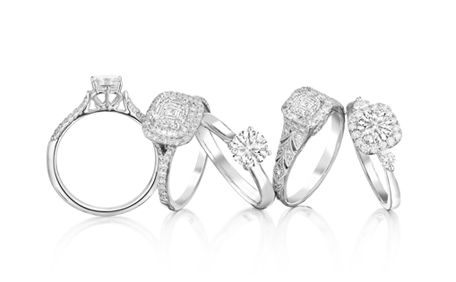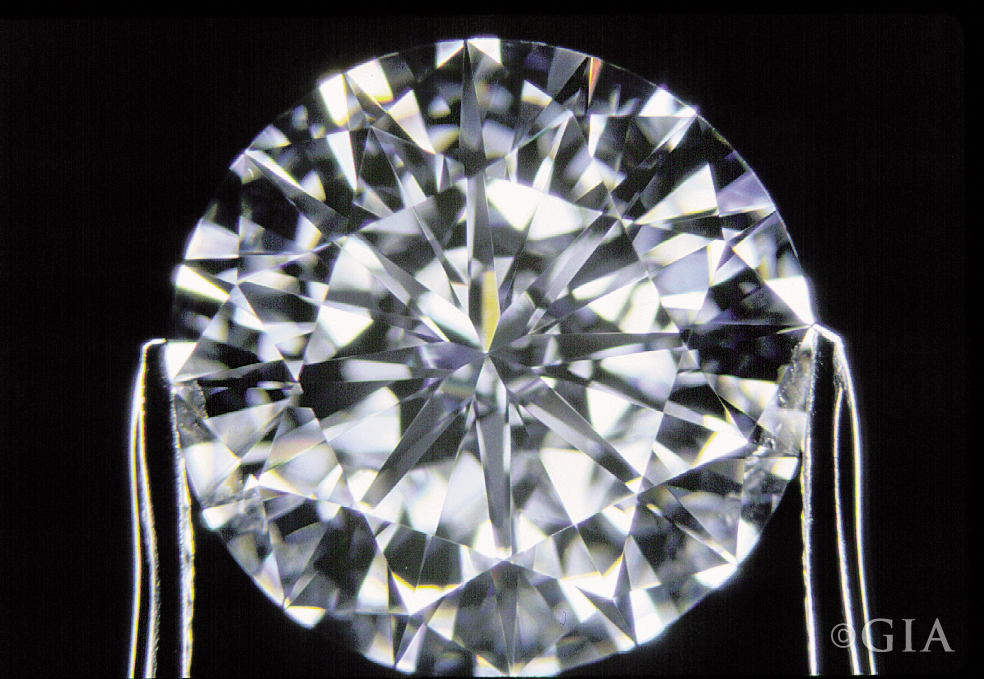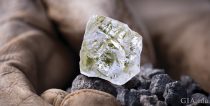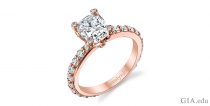Congratulations! You’ve begun shopping for a diamond engagement ring, or at least you’re starting to do your research. As you go through the process, you’re going to come across diamond terms and concepts, some that you never knew before. We want to make the diamond buying process easier for you. So, here’s a list of frequently used diamond engagement ring terms and their explanations, in one simple, handy cheat sheet.
Familiarize yourself with these diamond engagement ring terms, and you’ll be able to have a meaningful conversation with your jeweler. And remember, if there’s something you don’t understand, don’t hesitate to ask your jeweler.
Essential Information: The 4Cs of Diamond Quality
- The 4Cs: The four factors (Color, Clarity, Cut and Carat weight) that describe a diamond’s quality – and quality is inextricably linked to price. Created by GIA, these four value factors form the basis of the international diamond grading system GIA developed and introduced in the 1950s. Each “C” is evaluated differently and its quality communicated using different scales, so you’ll want to be familiar with all four C’s in order to understand the quality (and price) of any given diamond. See below for separate entries on each of the Cs.
- Diamond Color: The color grade of most gem-quality diamonds is based on the absence of color and rated on a 23-point scale that ranges from “D” (colorless) to “Z” (light yellow or brown). The distinctions between diamond color grades can be so subtle that they are invisible to the untrained eye. But they do make a very big difference in diamond quality and price.
- Diamond Clarity: A diamond’s relative lack of “imperfections” – known as clarity characteristics. Clarity characteristics located on the surface of the diamond are called blemishes. Located inside the diamond, they are called inclusions. The diamond’s clarity is determined by the number of inclusions, the size of the inclusion in relation to the size of the diamond, location, relief (how easy it is to see it) and nature (the type of characteristic and its inherent effect on the diamond). All of these factors relate to each other when determining a clarity grade.
- Clarity is measured using a scale of 11 grades that range from Flawless (no inclusions or blemishes are visible to a skilled diamond grader using 10× magnification) to Included (inclusions are obvious without magnification and may affect a diamond’s transparency, brilliance or durability).
- Clarity is measured using a scale of 11 grades that range from Flawless (no inclusions or blemishes are visible to a skilled diamond grader using 10× magnification) to Included (inclusions are obvious without magnification and may affect a diamond’s transparency, brilliance or durability).
- Diamond Cut: The quality of a diamond’s cut takes into account how well a diamond reacts to light and the stone’s overall design and craftsmanship. Not to be confused with shape (see Shape).
- In evaluating a diamond’s interplay with light, a cut grade reflects:
- Brightness or how white light reflects from a diamond
- Fire or the scattering of white light in all the colors of the rainbow
- Scintillation or the pattern of light and dark areas caused by reflections within the diamond
- The quality of a diamond’s design and craftsmanship takes into account:
- the weight of the diamond relative to its diameter
- the diamond’s girdle thickness which affects its durability
- the symmetry of the diamond’s facets arrangements
- the quality of the polish on the facets
- Based on these components, a diamond’s cut grade is rated on a GIA Cut Scale that ranges from excellent to poor.
- In evaluating a diamond’s interplay with light, a cut grade reflects:
- Diamond Carat Weight: The international unit of measurement for gem weight is the metric carat. It is expressed as 1.00 ct and consists of 100 points, so a half carat diamond weighs 0.50 ct or 50 points. One metric carat equals 1/5 of a gram (0.200 g) or about 0.007 ounces.
Other Important Diamond Terms
- Branded diamonds and diamond cuts: A diamond with a patented or trademarked cutting style. Some companies have their name or logo laser inscribed on the girdle of a diamond. Tiffany & Co. is an example.
- Brilliant Cut: A gem cutting style used for a variety of shapes such as round, oval, cushion, pear, marquise, heart, etc. It utilizes kite and triangular shaped facets (except for the table facet) that radiate from the center of the gem toward the girdle.
- Certificate (or “cert”): A common term used to refer to a document that contains an evaluation of a diamond’s 4Cs as well as other identifying characteristics. This is also a misnomer sometimes applied to GIA grading reports. A GIA diamond grading report is GIA’s opinion about the quality of the diamond represented in the report. Because GIA is an independent grading laboratory, this ensures an unbiased assessment of your diamond’s qualities.
- Clarity enhanced: A broad term used to describe a diamond that has had its clarity altered by the use of laser drilling or fracture filling. Treatments should always be disclosed.
- Colored diamonds: Diamonds with so much color they do not fall into the D-to-Z scale. They can be yellow, pink, blue, and other colors.
- Conflict diamonds: Diamonds that originate from areas controlled by forces or factions opposed to legitimate and internationally recognized governments, and are used to fund military action in opposition to those governments. The Kimberley Process, which counts 54 companies representing 81 countries, ensures that rough diamonds are mined in humane conditions. Some 99.8% of diamonds are now conflict-free. So you can go shopping with a clear conscience.
- Cubic zirconia (CZ): A man-made diamond simulant. See Simulant.
- Diamond Dimensions: See Diamond Cut.
- Facets: Flat, polished surfaces on a finished gem that reflect light. Common facet shapes include triangles, kite shapes, octagons and trapezoids.
- Fancy Color Diamond: See Colored Diamonds.
- Flawless: A diamond with no visible blemishes or inclusions when viewed under 10× magnification under a jeweler’s loupe by a trained grader. See Clarity.
- Flaws: An inaccurate term for inclusions and blemishes. See Clarity.
- Fracture filling: A clarity enhancement process that uses a glass-like substance to fill surface-reaching inclusions, such as feathers or laser drill holes, to make them less visible and improve the gem’s appearance. This treatment is not permanent as the filling can be can be reversed by certain types of jewelry repair. GIA will not issue grading reports on filled stones, only identification reports. This treatment should always be disclosed.
- Fluorescence: Visible light temporarily emitted by some diamonds and other gems when they are exposed to ultraviolet (UV) rays from the sun, fluorescent lamps, or other sources. This emitted light can display various colors (often blue in diamonds), intensities (faint to very strong), and distribution patterns. When the light source is removed, the fluorescence is no longer visible. Strong blue fluorescence can make a light yellow diamond look closer to colorless when exposed to a UV source such as sunlight. Blue and yellow are color opposites and tend to cancel each other out, so blue fluorescence masks the yellow color. Very Strong blue fluorescence can sometimes make the diamond look hazy or oily, which may lower the value of the diamond.
- Graduate Gemologist: Someone who holds a professional credential in gems and jewelry, earned from GIA. Considered the highest level of gemological training in the industry, GIA’s Graduate Gemologist curriculum provides an in-depth study of diamonds and colored stones, including their structures, origins, manufacture, and the factors that determine their quality. Many top jewelers and appraisers have earned this credential.
- HPHT Synthetic Diamond: A synthetic diamond produced in a laboratory with equipment that mimics the high-pressure, high-temperature conditions of natural diamond formation in the earth. HPHT is also used to treat natural diamonds to change their color.
- HPHT Treatment: A color enhancement process used to alter, enhance, or remove color in diamonds. HPHT can change some brownish diamonds colorless or transforms these brownish stones into other colors like yellow, greenish yellow, or green. This process is also associated with treated pink, blue, and orange-yellow diamonds. HPHT is considered a permanent process and should always be disclosed.
- Imitation: See Simulant.
- Inclusion: An internal clarity characteristic in a diamond or other gem. The number, size, position, color, and nature of the characteristics inside or on the surface of a diamond determine the stone’s clarity grade.
- Laser drilling: A clarity enhancement process used to improve the appearance of a diamond that contains dark inclusions. A hole is drilled into the diamond with a laser to reach the inclusion. If the included material is not vaporized by the laser itself, it is dissolved or bleached with acid. This is a permanent treatment and laser drill holes affect the clarity grade. GIA will issue grading reports on laser drilled diamonds providing there is no added filler. This treatment should always be disclosed.
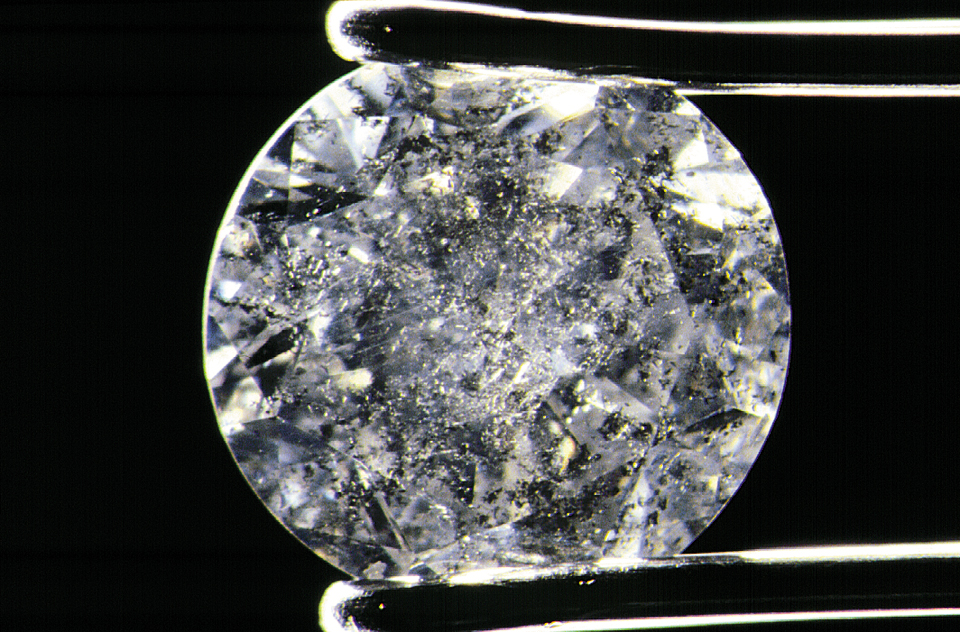
This diamond has so many inclusions it looks like the surface of the moon.
Courtesy K.R. Gems & Diamonds International. Photo: John I. Koivula/GIA
- Laser inscription: An identifying number, mark, or words placed on the girdle of a polished diamond using a laser. They are visible with a jeweler’s loupe or gemological microscope using 10× magnification. Common inscriptions include the diamond’s grading report number, a company’s logo, or even a personal message.

This inscription is a unique identifier of this diamond. Laser inscriptions do not affect the clarity grade. Photo: Mitch Moore/GIA
- Loupe: A small, portable, hand-held magnifying lens used for examining gemstones. The magnification of loupes may vary, but 10× magnification is considered the standard in gemology.
- Magic Sizes: Refers to diamonds weighing 0.50 ct, 0.75 ct, 1.00 ct, etc. Visually, there’s little difference between a 0.99 ct diamond and one that weighs a full carat (1.00 ct), but there may be a noticeable difference in the price per carat.
- Melee: (pronounced “meh-lee”) A jewelry trade term used to describe small diamonds, weighing less than 1/5 carat (˂0.20 ct). The exact size range of melee varies from country to country, and from one segment of the trade to another.
- Moissanite: A man-made diamond simulant. See Simulant.
- Princess Cut: Trade name for a square- or rectangular-shaped brilliant cut diamond that’s a popular choice for engagement rings
- Round Brilliant Cut: The most popular shape and cutting style for a diamond engagement ring. A standard round brilliant has 57 or 58 facets.
- Shape: The diamond’s outline when viewed face up. (Not to be confused with cutting style, which refers to the diamond’s facet arrangement or cut quality.) The most common diamond shape is round. All other diamond shapes are known as fancy shapes, and these include the marquise, pear, oval, rectangle, heart, and square.
- Simulant: A natural or man-made material that mimics the appearance of, and is used as a substitute for, another gem material. Simulants can be natural gemstones of another variety, synthetic stones, glass, composite materials, assembled stones, reconstructed material or any man-made material including plastic.
- Solitaire: An engagement ring with one gem as the focal point, typically a diamond. The center stone is often a standard round brilliant, but it can be any shape and cutting style.
- Sparkle: The flashes of light and the contrasting dark areas caused by reflections within a faceted diamond that are seen when the gem, light source, or observer moves. Gemologists call this scintillation.
- Synthetic: A laboratory-grown diamond or other gem material with virtually the same chemical and physical properties as a natural gem. Also called a lab grown diamond.
- Treatment: Any process used to improve the apparent color and/or clarity of a diamond. Treatments (often called enhancements) can be permanent (like HPHT process) or unstable (like fracture filling). As part of its grading process, GIA tests all diamonds for treatments. If a diamond is treated, the treatment is disclosed on the grading report.
- Triple Ex: A trade term that refers to a standard round brilliant diamond with a GIA grading report that has an overall cut grade of Excellent with Excellent polish and Excellent symmetry.
Thank you for checking out our glossary of diamond engagement ring terms. Did you know? The solitaire setting is one of the most popular choices for engagement rings. We’ve got a blog that can get you up to speed on this perennial favorite.

